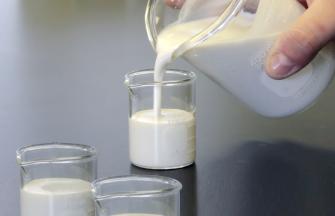
What is Milk of Lime?
Milk of lime is a highly alkaline (basic) material (pH ~12.5) with a large number of industrial uses, as well as health and safety considerations. Chemically speaking, it is a suspension of calcium hydroxide, chemical formula Ca(OH)2, particles in water. This suspension of Ca(OH)2 usually contains between 18% and 40% Ca(OH)2 by weight of solids.
Milk of lime is also known by a number of other generic terms, such as lime slurry, whitewash and limewater, as well as a range of proprietary names, such as CALSAFE®.

Making Milk of Lime
Milk of lime is made by mixing calcium oxide (CaO) with water in an exothermic reaction known as lime slaking:
CaO calcium oxide + H2O water →Ca(OH)2 milk of lime
This reaction initially produces a fine dry calcium hydroxide powder solution (hydrated lime or slaked lime). Continuing to add water allows for the liquid solution known as milk of lime to be produced.
The exothermic heat of the slaking reaction of milk of lime requires a specialized piece of equipment, known as a lime slaker, to safely control and contain the slaking reaction.
Users of milk of lime may choose to slake quicklime on site, or source pre-slaked dry calcium hydroxide. This latter material can simply be added to water in a mix tank (i.e. no slaker is required). Alternatively, ready-made milk of lime can be sourced from suppliers such as Carmeuse.
Milk of lime storage is important. The milk of lime is usually consumed before any degradation in quality occurs. That said, over time the calcium hydroxide particles will react with carbon dioxide (CO2) in the atmosphere to produce calcium carbonate lime (CaCO3). This adversely impacts the effectiveness of the slurry in whatever process or application it is being added to.
What is Milk of Lime Used for?
As mentioned above, milk of lime has a broad range of industrial uses:
- Milk of lime is used in water and wastewater treatment processes for pH adjustment, contaminant removal, disinfection and water softening.
- Milk of lime is used to help separate non-ferrous metals from their parent rocks, either in flotation processes or as part of metathesis (double displacement) reactions.
- Milk of lime is used as a base (alkali) for pH adjustment, as a desiccant or, again, in metathesis reactions in the manufacturing of chemicals.
- Milk of lime is used to modify and stabilize soils, particularly clay soils, in civil engineering and construction applications.
- Milk of lime is used for biosolid treatment and soil improvement in agriculture.
- Milk of lime is used to help purify raw sugar juice in sugar refining.
More niche applications for milk of lime include as a primary supplement of calcium and alkalinity for reef aquariums, fresh plaster, in buon fresco painting as color solvent, and for making maize-based foodstuffs, such as corn tortillas (nixtamalization).
Go Deeper on Milk of Lime Uses
For more information on calcium hydroxide suspensions like milk of lime and its uses, check out our article on how to choose the right lime product for water/wastewater treatment or our good practice guide to lime slurry handling. Or you may be interested in going a little deeper with our white paper outlining considerations for a successful CALSAFE lime slurry trial.
Finally, to get into the specific details of your particular application or technical query, the experts at the Carmeuse Innovation Center in Pittsburgh are always on hand to answer your questions and support the optimal use of lime products at your operation.




